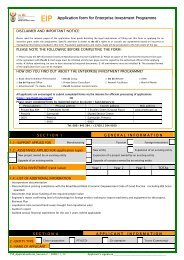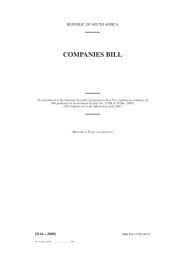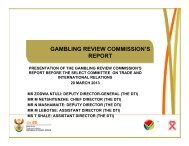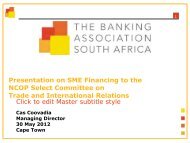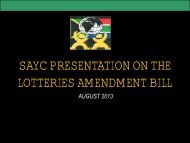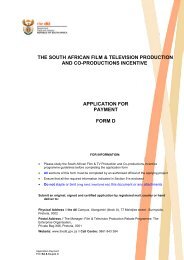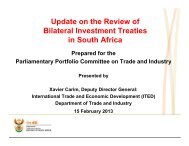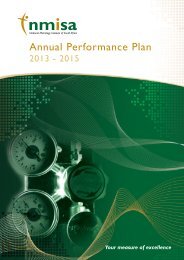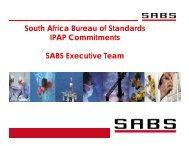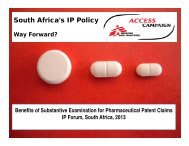Copyright Review Commission Report - ICT Law and Regulation ...
Copyright Review Commission Report - ICT Law and Regulation ...
Copyright Review Commission Report - ICT Law and Regulation ...
- No tags were found...
Create successful ePaper yourself
Turn your PDF publications into a flip-book with our unique Google optimized e-Paper software.
(1) Subject to the provisions of this Act, no person shall without the consent of the performer (a) broadcast orcommunicate to the public a performance of such performer, unless the performance used in the broadcast or thepublic communication is itself already a broadcast performance or is made from a fixation of the performance or from areproduction of such a fixation.3.1.13. This Section was modelled on Article 7 of the Rome Convention. It allows for the broadcasting orcommunicating to the public of a recording without the consent of the performer, if the performance haspreviously been fixed. As Owen said (op. cit., p156), “[t]his is a serious restriction, given that the majority ofperformances that are broadcast <strong>and</strong> communicated to the public are embodied in a fixation.” In such a case,however, the performer was entitled to equitable remuneration under Article 12 of the Convention, which readsas follows:If a phonogram published for commercial purposes, or a reproduction of such phonogram, is used directly forbroadcasting or for any communication to the public, a single equitable remuneration shall be paid by the user to theperformers or to the producers of the phonogram or both. Domestic law may, in the absence of agreement betweenthese parties, lay down the conditions as to the sharing of the remuneration.3.1.14. Despite the fact that Article 12 has been described as “the most important provision in the Convention” (Owen,op. cit., p172), the Act did not contain a section modelled on Article 12 <strong>and</strong> broadcasters continued to playcommercial recordings without the consent of the performers or paying them any remuneration.3.1.15. After playing sound recordings, South African broadcasters paid royalties in terms of tariffs that had beenagreed with the collecting society representing the composers <strong>and</strong> the publishers who held the copyrights to theworks played under Section 6 (d) of the <strong>Copyright</strong> Act, viz. SAMRO. They also paid royalties to one of thecollecting organisations representing the record producers who held the copyrights to the recordings played interms of Section 9 (a) of the Act (the so-called ‘mechanical rights’), viz. NORM or SARRAL.3.1.16. The tariffs, in terms of which royalties were paid in respect of the Section 6 (d) rights, were agreed with SAMRO.If SAMRO <strong>and</strong> the broadcasters were unable to agree on what tariff should apply or SAMRO had refused togrant a licence, the broadcasters could apply for relief to the <strong>Copyright</strong> Tribunal. The Tribunal wasoriginally established under the 1965 Act, following the approach adopted in the British Act of 1956. The BritishParliament had set up a tribunal, originally known as the Performing Right Tribunal, to provide a remedy formajor copyright users who had complained about the terms on which the performing rights societies were doingbusiness. The Tribunal was established after the Gregory Committee (whose report on copyright reform wasaccepted on this <strong>and</strong> other points by the British Parliament) found that certain societies were abusing themonopoly rights conferred on them.3.1.17. The present Act re-enacted the provisions in the 1965 Act dealing with the <strong>Copyright</strong> Tribunal. Section 29 (1)provides that the judge or acting judge, designated from time to time as the <strong>Commission</strong>er of Patents in terms ofSection 8 of the Patents Act 57 of 1978, shall also be the Tribunal. The function of the Tribunal, in terms ofSection 30, is to determine disputes between licensing bodies or other persons from whom licences wererequired <strong>and</strong> persons requiring licences or organisations claiming to be representative of such persons.<strong>Regulation</strong>s dealing with the procedure before the Tribunal have been made under Section 29 (3) of the Act:see Government Notice R2530 published in Government Gazette 6252 of 22 December 1978, asamended. <strong>Regulation</strong> 27 (3) provides that, subject to the regulations, the Tribunal may regulate the procedure- 16 -



